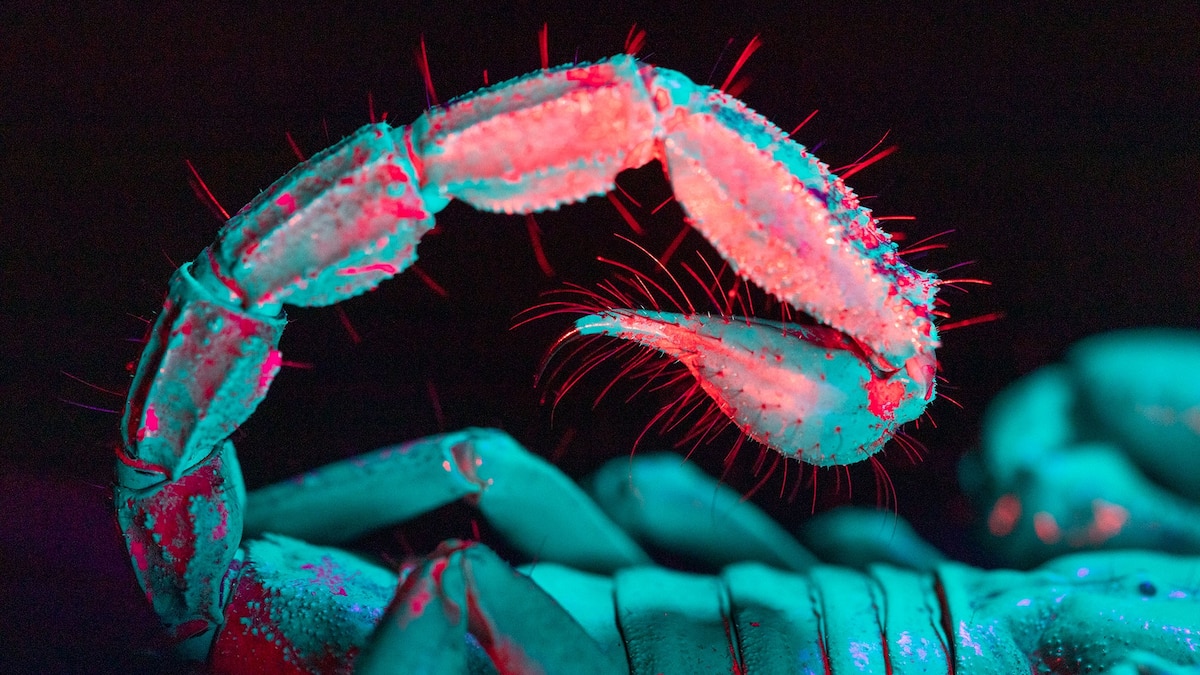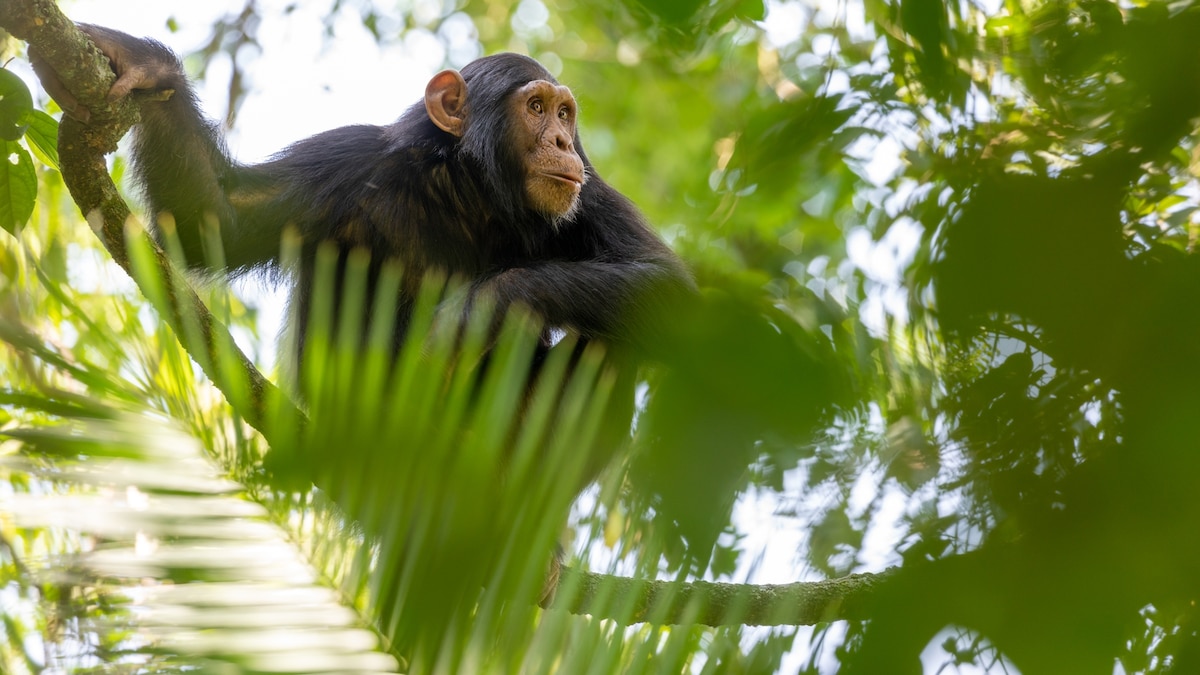Now Reading: Pink squirrels and green sharks—why do so many animals ‘glow’ in UV light?
-
01
Pink squirrels and green sharks—why do so many animals ‘glow’ in UV light?
Pink squirrels and green sharks—why do so many animals ‘glow’ in UV light?

Shine an ultraviolet flashlight on flying squirrels, and they glow bright pink. Catch a scorpion on a full moon, and you’ll notice that it’s a haunting blue. Rays and sharks can turn neon green, while nearby coral come alive in electric reds.
And hawksbill sea turtles? Under ultraviolet light, they turn into glow-in-the-dark, underwater Christmas decorations, with both greens and reds arranged in overlapping chevrons.
Each of these glowing animals is an example of photoluminescence—the property of being able to reflect or absorb and re-emit ultraviolet (UV) light from the sun, moon, or an artificial UV light source. Some animals absorb the UV wavelengths and reflect visible wavelengths, while others seem to display UV coloration—invisible to the human eye without specialized cameras. Sometimes referred to as fluorescence, phosphorescence, or even biofluorescence, it seems like every day scientists continue to discover this suite of phenomena in new and exciting places.
(Read more about flying squirrels that secretly glow pink.)
In the last year, citizen scientists have uncovered glowing geckos and millipedes using UV flashlights in their own backyards. And researchers have added snakes to the long list of animals that exhibit photoluminescence—out of 110 species of snake from Colorado down to Peru, fully 90 percent showed at least some signs of ultraviolet coloration, or reflection of UV light.
The findings echo previous studies which have revealed that 92 percent of 187 frog species had photoluminescent skin. Other researchers identified 95 species of coral reef fish that glow in ultraviolet and 181 species of bird with photoluminescent plumage. Not to be left out, 95 percent of 148 mammals tested also had photoluminescent fur.
“Recent papers that have come out have kind of made it out that it’s a really rare, special thing. Like, ‘we found one, and that’s the only one’ kind of thing,” says Linda Reinhold, a zoologist at James Cook University in Australia and lead author of the mammal study, published in the Australian Journal of Zoology in 2023. “But it’s the norm, not the exception.”
“When I was out in the forest at night watching live animals, they pretty much all glow,” she says.
But even if photoluminescence is more common than we thought, there is still one great mystery underlying the phenomenon—that is, what if anything does all this hidden glow mean?
From reproduction to protection

A flying squirrel glows pink under UV light at Nebraska Wildlife Rehab.
Photograph by Nebraska Wildlife Rehab/Alex Wiles
While scientists have discovered that bioluminescence—or when an organism creates its own light—can be used to attract prey or mates, as anglerfish and fireflies do, the utility of photoluminescence is very much still up in the air. In fact, nearly everything scientists know about the phenomenon is related to just one aspect of biology.
“We did a comprehensive literature review that looked at the reported functions of UV color and found that, actually, almost all the reported function is really heavily skewed towards reproduction,” says Hayley Crowell, a herpetologist at the University of Michigan and lead author of the snake study.
For instance, some plants use ultraviolet coloration to guide pollinators to their flowers, and some birds appear to use ultraviolet colorations as part of their mate selection process, as evidenced by the neon beaks of puffins.
(Read more about the surprising discovery of glowing puffin beaks.)
And this is what makes the new snake study so interesting.
Because scientists found no difference between male or female snakes with regard to UV coloration, and because their ability to reflect UV light seemed to have more to do with habitat differences, such as living in trees, the researchers believe that predators might actually be what’s driving some snakes to glow—or not.
In one example, prairie rattlesnakes live out in the open, but they had almost no UV coloration. “They are like ghosts on the landscape,” says Crowell.
Whereas those snakes’ close cousins, tree vipers found in the tropics from the genus Bothrops, displayed what she calls “full UV coloration.” As to why there should be such a big difference between what are almost sister species, Crowell suspects it has to do with the ability of bird predators to see into the ultraviolet range. (Studies suggest that snakes can see in UV too, but snake vision wasn’t part of Crowell’s study.)
In other words, snakes living in the canopy are already somewhat protected from eyes in the sky, and anyway, many plants also reflect ultraviolet light, so such colorations may actually act like camouflage among the foliage. Likewise, prairie rattlesnakes may have evolved to get rid of their UV colorations on a landscape where reflecting UV would make them stand out like a neon sign in a diner window.
You May Also Like
“It’s really easy to get hung up on this being like some amazing, super-secret,” says Crowell. “When in reality, we just have to treat it like any other color. Like, there are scenarios where green will help you hide, and scenarios where green is terrible to have, because you’ll stand out.”
Elsewhere in the animal kingdom several studies seem to suggest scorpions may be able to use their glowing exoskeletons to sense ultraviolet light and move away from it—perhaps as a way to hide themselves on moonlit nights. Similarly, another study found birds prefer to eat caterpillars that were not photoluminescent, hinting at the possibility that insects use an ultraviolet glow as a way to warn off predators—like a skunk’s stripes or a poison dart frog’s bright colors.
What scientists can learn from glowing roadkill
While the snake study and other examples provide tantalizing evidence for camouflage, the purpose of UV photoluminescence in mammals is a mystery.
When Reinhold and her colleagues tested how wildlife interacted with rat models made of real fur, which appears bluish-white in ultraviolet light, as opposed to rat fur models that had been treated to remove their glow, they found no preference for either model—neither during the new nor full moon, nor among herbivores and carnivores, nor even among placental mammals, marsupials, nor birds.
“There was no pattern to it,” says Reinhold, who published the study in the Australian Journal of Zoology in 2024.
This was especially disappointing, in part because back in 2023, Reinhold had tested fur—mostly roadkill samples—from 141 Australian mammal species and found that 95 percent had some photoluminescent properties.
“You’d stop by the side of the road and find something dead and turn your torch on it, and it was just dazzling,” she says. “And just time after time, going through the freezers at the university… it was like a box of chocolates!”


An opossum glows pinkish purple under ultraviolet light at Nebraska Wildlife Rehab. Under visible light, its coat is much less vibrant. Without UV flashlights or specialized cameras, photoluminescence is invisible to the human eye.
Photograph by Nebraska Wildlife Rehab/Alex Wiles (Top) (Left) and Photograph by Nebraska Wildlife Rehab/Alex Wiles (Bottom) (Right)
Photoluminescence may be the norm under the sea
Land animals aren’t the only ones to glow under UV light, and in some ways the phenomenon makes more sense in the ocean because of how underwater environments impact light.
In the 2000s, David Gruber was studying photoluminescent coral when he saw something no one had ever seen before—an eel that looked like it’d been dipped in ectoplasm from Ghostbusters.
This led him to turn his ultraviolet light on fishes of all shapes and sizes, and eventually revealed the glowing sea turtles and sharks mentioned above. Later, he and his team would even create a camera that revealed just how vibrant these sharks would appear to each other.
Shark-vision, in other words.
“It was kind of like dropping into a portal of the marine world that all these different marine creatures had been tuned into, but we hadn’t been,” says Gruber, who is a marine biologist at the City University of New York, as well as a National Geographic Explorer.
Because the upper parts of the ocean act like a blue light filter, Gruber says, only UV light permeates farther depths. So the ability to absorb ultraviolet and re-emit it in other colors makes more logical sense for ocean creatures than it does for those living up on the land.
Though he notes that scientists still need to look at the visual systems of each creature to determine whether they can actually perceive those colors, as the cat sharks can. Understanding how the colors are perceived by both the creatures displaying them and their predators could help reveal their function.
“We can go underwater and revisit some of these animals that were described for the first time hundreds of years ago,” says Gruber. “We can see them in a new light and find things that are meaningful to them and to their world that we just hadn’t known before, because we didn’t have the tools to examine them.”
























